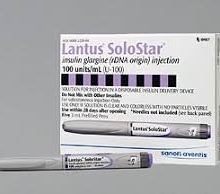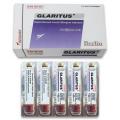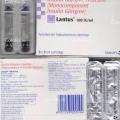Home / Categories / LANTUS SOLOSTAR

LANTUS SOLOSTAR
(1)
INSULIN GLARGINE
LONG ACTING INSULIN
AVENTIS PHARMA LTD
Product Details
I
Insulin Analogs
A to Z Drug Facts
Insulin Analogs
Actions
Indications
Contraindications
Route/Dosage
Interactions
Lab Test Interferences
Adverse Reactions
PrecautionsPatient Care Considerations
Administration/Storage
Assessment/Interventions
Patient/Family Education
(IN-suh-lin)Insulin AspartNovoLogInjection100 IU/mL human insulin aspart (rDNA)Insulin GlargineLantusInjection100 IU(3.6378 mg) insulin glargineInsulin LisproHumalogInjection100 IU/mL Human insulin lispro (rDNA)Humalog Mix 75/25Injection100 IU/mL Human insulin lispro (rDNA)Humalog Mix 50/50Injection100 IU/mL Human insulin lispro (rDNA)Class: Antidiabetic
 Action Regulates proper glucose use in normal metabolic processes.
Action Regulates proper glucose use in normal metabolic processes.
 Indications
Indications
Insulin Aspart
Treatment of patients with diabetes mellitus for the control of hyperglycemia; however, because of rapid onset and short duration of action, insulin aspart should normally be used in regimens that include an intermediate- or long-acting insulin.
Insulin Glargine
Treatment of patients with diabetes mellitus who require long-acting insulin for control of hypoglycemia.
Insulin Lispro
Treatment of patients with diabetes mellitus for control of hyperglycemia. In patients with type 1 diabetes, use in regimens that include a longer-acting insulin. In patients with type 2 diabetes, may be used without longer-acting insulin when used concurrently with sulfonylureas.
 Contraindications During episodes of hypoglycemia; hypersensitivity to any component.
Contraindications During episodes of hypoglycemia; hypersensitivity to any component.
 Route/Dosage
Route/Dosage
Insulin Aspart
Adults: SC Individualized; determined by health care provider in accordance with patient's needs (usual requirement 0.5 to 1 units/kg/day). Insulin pump When used in the external insulin infusion pump, the initial pump programming is based on the total insulin dose of the previous regimen. Although there is interpatient variability, approximately 50% of the total dose is given as meal-related boluses, and the remainder as basal infusion.
Insulin Glargine
Adults and Children at least 6 yr: SC Once daily at bedtime, dose determined by close monitoring under medical supervision during change from a treatment regimen with an intermediate- or long-acting insulin.
Insulin Lispro
NA
Type 1 Diabetes
Adults: SC Variable; determined by health care professional.
Type 2 Diabetes
Adults and Children older than 3 yr (in combination with sulfonylureas): SC Variable; determined by health care professional.
Insulin Lispro Mix
Adults: SC Variable; determined by health care professional.
 Interactions
Interactions
Oral Contraceptives, Corticosteroids, Estrogens, Isoniazid, Niacin, Phenothiazines, Thyroid Hormone: May decrease hypoglycemic effects of insulin lispro.
Alcohol, Angiotensin-Converting Enzyme Inhibitors, Beta Blockers, MAO Inhibitors, Oral Hypoglycemic Agents, Pancreatic Function Inhibitors (eg, Octreotide, Salicylates, Sulfa Antibiotics): May increase hypoglycemic effects of insulin lispro. Beta blockers may mask the symptoms of hypoglycemia in some patients.
 Lab Test Interferences None well documented.
Lab Test Interferences None well documented.
 Adverse Reactions
Adverse Reactions
DERMATOLOGIC: Lipodystrophy (from repeated insulin injection into same site). METABOLIC: Hypoglycemia; hypokalemia. OTHER: Hypersensitivity reaction (eg, rash, shortness of breath, fast pulse, sweating, hypotension, anaphylaxis, angioedema); local reactions (eg, redness, swelling, and itching at injection site).
 Precautions
Precautions
Pregnancy: Category B (insulin lispro); Category C (insulin aspart, insulin glargine). Lactation: Undetermined. Children:
Insulin aspart- Safety and efficacy not established. Insulin Glargine- Safety and efficacy not established in children less than 6 yr with type 1 diabetes. Insulin Lispro- In combination with sulfonylureas, safety and efficacy not established in children up to 3 yr. Insulin Lispro Mix- Safety and efficacy not established in children up to 18 yr.
Changing Insulin: Changes in purity, strength, brand, type, species source, or method of manufacture (rDNA vs animal source) of insulin may necessitate dosage adjustment. Make changes cautiously under medical supervision.
Renal/Hepatic Impairment: Insulin lispro dose may need to be reduced.
Hypoglycemia: May result from excessive insulin dose, missed meals, increased work, or exercise without eating.
PATIENT CARE CONSIDERATIONS
 Administration/Storage
Administration/Storage
- When mixing insulins, draw insulin lispro into syringe first. Administer immediately after mixing.
- Do not administer mixtures IV.
- Use only insulin syringes.
- Select appropriate injection site according to patient history and needs; rotate injection sites to prevent lipodystrophy. SC insulin lispro is absorbed most rapidly at abdominal injection sites, more slowly at sites on arms, and slowest at sites on anterior thigh.
- Administer insulin lispro 15 min before meals.
- Do not freeze. Do not use insulin lispro if previously frozen.
- Do not expose to extreme temperature or direct sunlight.
 Assessment/Interventions
Assessment/Interventions
- Obtain patient history, including drug history and any known allergies.
- Assess patient for signs of hypoglycemia (eg, anxiety, chills, confusion, cool and pale skin, drowsiness, excessive hunger, headache, irritability, nausea, rapid pulse, tremors).
- Observe patient for signs of hyperglycemia (eg, drowsiness, fruitlike breath odor, frequent urination, loss of appetite, thirst).
- Monitor blood glucose levels throughout course of therapy.
- Observe injection sites for signs of local hypersensitivity reaction, such as redness, itching, or burning.
- Notify health care provider if hypoglycemia or adverse reactions occur.
- If lipoatrophy or lipohypertrophy develop at injection site, use alternate sites or use purified insulin.
- Document injection sites used.
OVERDOSAGE: SIGNS & SYMPTOMS Fatigue; weakness; nervousness; confusion; headache; diplopia; convulsions; psychosis; dizziness; unconsciousness; rapid or shallow respiration; numb or tingling mouth; hunger; nausea; skin pallor; moist or dry skin
 Patient/Family Education
Patient/Family Education
- Teach name, dose, action, and side effects of insulin.
- Tell patient not to change brand, strength, type, or dose without health care provider's knowledge.
- Dosage adjustments may be necessary when type of insulin is changed.
- Tell patient to consult health care provider for dosage changes during illness.
- Instruct patient to use same type and brand of syringe each time to prevent dosage errors.
- Explain potential long-term complications of diabetes and encourage regular general physical and eye examinations.
- Tell patient to report redness, swelling, or itching at injection site.
- Explain significance and importance of reporting the following side effects: visual changes; rash; infection that does not heal; increased thirst; increased urination; dry mouth; burning sensation in feet, legs, or hands; pain in legs after exercise; frequent episodes of low or high blood sugar levels.
- Show patient how to rotate injection sites to prevent scarring.
- Teach patient how to monitor blood glucose as directed.
- Identify source for obtaining medical ID (eg, Medi-Alert) and explain importance of information.
- Teach patient and family how to draw up and administer insulin.
- Demonstrate self-care techniques using insulin pump for patients.
- Emphasize importance of compliance with diet and exchange system for meals.
- Emphasize importance of regular exercise.
- Tell patient to carry source of sugar (eg, candy, sugar packets) to counteract hypoglycemia.
Books@Ovid
Copyright © 2003 Facts and Comparisons
David S. Tatro
A to Z Drug Facts


